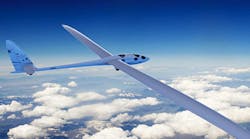MINDEN, Nev. — The space glider Perlan 2 is helping Airbus take on Silicon Valley’s brightest innovators, even while pursuing technologies that might eventually lead to passenger flights in space.
The project’s goal is to set an altitude record for the unpowered craft of 90,000 feet in the frigid temperatures at the edge of space (negative-70 Fahrenheit, negative-57 Celsius), similar to the conditions on Mars.
The European aerospace firm has invested close to $4 million in the American group, Mission Perlan 2, which developed the ambitious project, and tested the craft Saturday in the skies over Nevada.
That sum makes Airbus the leading partner in Perlan 2, according to a source familiar with the deal. It represents 57% of the $7 million budget raised to build the glider. If that amount seems paltry compared to the billions traditionally spent on new aeronautics technologies, it is still unexpected coming from a corporation whose work has always centered on passenger planes and helicopters.
“We make the airplane as simple as we can make it, so there is nothing we are doing that is cutting-edge for Airbus,” Ed Warnock, chief executive of Perlan 2, told AFP.
Why, then, the interest by the huge conglomerate?
“It’s an innovative project; this one fits very well to our image, to our reputation as an innovative company,” said Tom Enders, Airbus’s boss, who was co-pilot during Perlan 2’s flight Saturday, which was cut short by cloudy conditions. “It can contribute to research, and more importantly it can keep enthusiasm for flights (and be) inspirational for younger generations.”
A ‘Leading Force’
Experts say Airbus, founded in 1969 during the golden age of space conquest, figures that by linking itself to Perlan 2’s stratospheric exploits, it can kill two birds with one stone.
If Perlan 2 manages to break the altitude record set in 1976 by the US Air Force’s SR-71 reconnaissance plane — as it hopes to do later this year in Argentina — Airbus’s name will go into the history books along with those of other great aeronautics pioneers.
At the same time, Airbus hopes to bask in the glow surrounding the visionary American billionaires Elon Musk (SpaceX) and Jeff Bezos (Blue Origin) as they work to develop reusable launch vehicles. In less than 20 years, these late arrivals to the space race have become the center of attention for the aerospace industry, relegating traditional actors to the background.
Their technologies can also be used to collect data important for scientific research (as with climate change) or in detecting trends in natural resources like petroleum.
“Innovation is not happening just in Silicon Valley,” Enders said, adding that Airbus could be a “leading force” in expanding scientific horizons and that “we are not afraid” to compete.
So Airbus, which recently opened a center for technological innovation in California dubbed A3, plans to get as much media exposure as possible from Perlan 2.
Next Up: Helicopters On Call?
But this is not its only futuristic project. In partnership with the Uber transportation company, Airbus wants to develop a helicopter-on-call service. Even more ambitious is a plan to build a flying car using artificial intelligence.
As conventional air corridors grow more crowded, Airbus wants to use Perlan 2 as a “platform” to test plans for airplanes that could cruise at altitudes of up to 60,000 feet, well above the current limits of 41,000 feet.
Perlan 2 will be collecting data on the tropopause — the region between the troposphere, the lowest portion of Earth’s atmosphere, and the stratosphere — to help determine at what point waves of moving air masses in that zone become “dangerous type waves,” Warnock said.
“Are we really going to build gliders? Probably not,” said Ken McKenzie, vice president for Airbus in North America. “But do we care about the first pressurized glider that has ever flown — that sounds pretty interesting.
“It’s all carbon fiber — that’s something we are excited about. They put integrated life support systems into a glider, and (we will) see how this can potentially be something we can use.”
Marco Caceres, a space analyst with the Teal Group, said Airbus aims to be a leading pioneer in the field: “Airbus is a commercial company, and so obviously they see a potential for profit, a potential for creating a new market, a new industry.”
By Luc Olinga
Copyright Agence France-Presse, 2016



